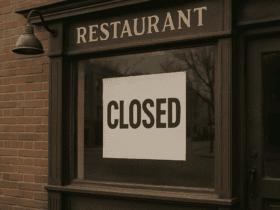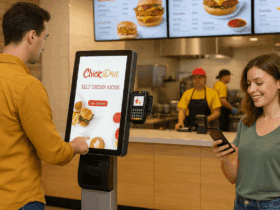Thinking of opening up a restaurant? Want to refurbish your premises? Need new kitchen equipment? Looking at starting another outlet? Considering automating operations? Want to rebrand? Whichever of these you answered yes to, you will need money to do it.
Restaurant financing refers to the money that is sourced in order to start, innovate, expand, change or grow a restaurant. It is the capital that you need to borrow or loan in order to be able to achieve your goals as a restaurateur. Now there are many sources of restaurant financing. As each of these takes a different form and comes with its own advantages and disadvantages, you need to be judicious about selecting the type of funding that best fits your needs.
We would like to help you make a more informed decision and so we have created a list of seven of the most common and widely used sources of restaurant financing. Read on and you will be able to learn about the pros and cons of each of them as a first step to figuring out which financing source would work for you.
7 Restaurant Financing Options To Keep An Eye On
1. Brick-and-mortar bank loans
Brick-and-mortar bank loans have to do with borrowing money from a bank for a specified period of time and involving a stipulated interest rate. Loans can be sought from both national and regional banks. Repayment is usually on a monthly basis.
There are two main advantages to these types of loans. It is possible to borrow a larger sum of money through traditional lenders and interest rates tend to be lower than other financing options. You will also be able to designate the term of the loan. In this way, you can select a time frame that will be practical for repayment. However, you should be sensible about not dragging on the loan for too long because you may be charged a high-interest rate for a longer term.
Among the drawbacks of brick-and-mortar term loans is the requirement for collateral. While it is possible to use either business or personal assets as collateral, not all restaurateurs are able to find the requisite value. Using personal property as collateral can bring with it the risk of losing your private belongings in the event that things go pear-shaped with the business. Banks also tend to be skeptical about restaurant loans as can be seen in the very low approval rates. And if yours is a completely new venture, then there may be stricter terms and conditions for loan approvals, making the process extremely difficult. Brick-and-mortar bank loans also take a very long time to be processed – approvals can take as long as 60 days.
2. Alternative Loans
Lenders other than banks, like online companies, also offer loans. The terms of these loans vary as does the interest rate. As is the case with banks, alternative lenders will also evaluate your credit score or carry out some other form of assessing the financial health of your restaurant before doling out money.
Alternative loans are processed very quickly, sometimes as fast as 24 hours, making it a good option if you need cash urgently. Most of these lenders do not require collateral and the approval rate for restaurant loans is much higher than that of banks. Non-bank lenders can sometimes be flexible about repayment. So rather than paying a fixed amount on a monthly or weekly basis, they could take a percentage of your daily or weekly credit card sales, keeping the repayment dynamic.
Alternative lenders may also need a proven track record before giving you money. This makes getting a loan for new ventures a tad difficult. Interest rates tend to be very high on alternative loans.
Must Read: It’s All About The Money: Five Pricing Strategies For Lucrative Menu
3. Small Business Administration Loans

The US Small Business Administration has a range of loans for differing requirements – opening a restaurant, buying property, purchasing equipment, carrying out renovations and so on. The money is sourced from a network of partner lenders, so while your loan is processed by the SBA you will be funded by a third party. Take a look at what kinds of loans are on offer and apply for the one most suited to your needs.
SBA loans have reasonable interest rates of between 5.5% and 8%. You will also not need to have a super high credit score to get a loan from the SBA. Their approval rate for restaurants is also much greater than both banks and alternative lenders. The SBA is willing to give loans up to $5.5 million which is perfect for those in need of large sums of money.
Among the drawbacks is the longer wait time compared with alternative loans – processing could take anywhere between 30 to 60 days. The application process is cumbersome, involving a lot of paperwork. The SBA may also require collateral if you need a higher sum of money (usually above $25,000) and this collateral requirement often includes investment assets.
4. Business Line Of Credit
A line of credit is issued by a bank or alternative lender but is different from a loan. Unlike with a loan, where you have access to the money just once, with a line of credit, you will be given a credit limit and you can access money multiple times for as long as it remains active. As is the case with a bank loan, repayment (principal plus interest) occurs on a regular basis.
A line of credit is particularly useful if you need access to small amounts of money for an extended period of time.
However, gaining approval for a line of credit is dependent on a healthy financial outlook. Therefore, it may not be easy to get a line of credit if your restaurant’s financial situation is shaky. A way around this is to apply for a line of credit in advance rather than wait until you need the money.
5. Merchant cash advance
A merchant cash advance (MCA) is a great way to get money in a hurry. Companies provide a loan and then collect a percentage of your credit and debit card transactions. The deduction can be on a daily or weekly basis and will carry on until the loan is repaid.
The most attractive part of an MCA is that you can get the cash mega fast, sometimes within a day. You don’t have to worry about your credit rating or showing a performance record. This makes it a highly viable option for new ventures.
A potential drawback of an MCA is the daily payback which can be very challenging when business is low.
6. Loans From Family And Friends
A friendly and informal source of funding, family and friends can often be counted on to have your back when you are in need. Since they know you and know the nature of your business, they will be more willing to support you. While this type of funding tends to be more casual than others, it is in your interest to have clearly articulated terms for the loan. Knowing when you need to repay by, if and how much interest you need to pay, and what happens if you are unable to meet the deadlines or conditions will preempt misunderstanding and souring of relationships. You should also keep in mind that you may still be held accountable for taxes no matter how casually the money has been lent to you.
One of the biggest benefits of borrowing money from family and friends is that they may not ask you for interest. The spirit of goodwill and a desire to support you can help you keep your loan cost down. You also do not need to go through the tedious application process required from other lenders. There will be no formal evaluations of credit scores and other factors.
That said, if you do not have a proper agreement, there is always the potential for tension and ruined relationships. Your lenders may also call in a favor when they need money and you may not be in a position to refuse.
Must Read: 7 Things You Should Know Before Building Your Restaurant Online Ordering App
7. Crowdfunding
Online crowdfunding platforms give you access to funding from a whole bunch of people in all corners of the world. With crowdfunding, outside parties pump money into your business in return for a benefit. These benefits can range from a free meal all the way up to shares in your establishment. This particular form of financing has proven to be particularly helpful for smaller, community-oriented ventures as these types of organizations tap into people’s sense of social consciousness.
Crowdfunding can be less complicated than applying to traditional loaning agencies like banks. The kind of publicity you generate can also be free marketing for your restaurant.
The tricky part about crowdfunding is that you have to hit your target. If you are unable to get the full amount you projected, then the money is returned to the relevant parties. You need to also be savvy about returns for investors. Some proprietors have found themselves losing the majority stake in their business due to incorrect calculations or a lack of foresight. You should also pay close attention to the commissions charged by the crowdfunding platforms, as some of them can be pretty steep.
As you can see, there are different kinds of restaurant financing options for different needs. Before you decide which source you will use, you must make a detailed budget. Beyond the total monetary requirement, you also need to plan how you will spend the money. This information will allow you to figure out repayment amounts and timing. Once you have all the specifics you can approach your chosen financing source and see your ideas come to fruition.










Leave a Reply